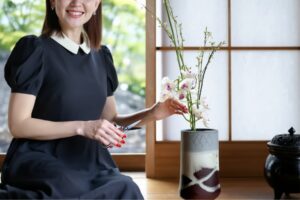You may already be familiar with the terms “tea ceremony” and “flower arrangement.” Both represent traditional Japanese cultural arts that are steeped in history and imbued with profound spiritual significance. However, what exactly distinguishes one from the other? In this article, we will provide a clear and comprehensive explanation of the basics of both tea ceremony and flower arrangement, as well as their key differences. If you are contemplating which one to pursue, this guide may assist you in discovering the path that best aligns with your interests.
What is Sado?

The tea ceremony is a refined cultural practice in Japan, where one learns and performs the art of preparing and serving matcha (powdered green tea). It is not merely a ritual for consuming tea but rather a spiritual endeavor aimed at fostering a sense of hospitality and personal growth. Through its practice, one cultivates an appreciation for tranquility, seasonal changes, and the shared experience within the tea room.
The Basic Flow of the Tea Ceremony
Before entering the tea room, participants respectfully cleanse their hands and mouths at a tsukubai (stone basin). This act symbolizes purification and a sense of reverence for the space. Once inside, the host carefully prepares matcha following traditional methods, while guests graciously receive the tea, rotating the tea bowl with care before drinking. Each movement embodies gratitude and respect, reflecting the core principles of the tea ceremony.
The History of the Tea Ceremony
The origins of the tea ceremony can be traced back to rituals practiced in Buddhist temples. It was in the 16th century that the renowned tea master Sen no Rikyū established the modern tea ceremony, emphasizing the concept of wabi-cha—a style characterized by simplicity and subtle elegance. This philosophy continues to serve as the foundation of the tea ceremony today.
The Appeal of the Tea Ceremony
One of the most compelling aspects of the tea ceremony is the opportunity it provides to find serenity amidst the demands of modern life. By engaging in its meditative practices, one can cultivate moments of peace and mindfulness.
What is Ikebana?

Flower arrangement, known as Ikebana, is another esteemed Japanese art form that expresses the beauty of nature and the sanctity of life through the arrangement of flowers. Unlike ordinary floral decorations, ikebana emphasizes harmony with nature, utilizing space and natural forms to achieve a sense of artistic balance and beauty.
The Basic Flow of Ikebana
The process begins with the careful selection of flowers, which are then artfully arranged in a vase. Particular attention is given to the shape, color, and overall balance between the flowers and the surrounding space to accentuate their natural beauty. A defining feature of ikebana is its focus on “space,” where the empty areas between flowers are as significant as the flowers themselves in conveying meaning and elegance.
The History of Ikebana
The practice of flower arrangement has its origins in the 6th century as offerings in Buddhist temples. Over time, it evolved among the nobility and samurai class, eventually developing into the sophisticated art form known today as ikebana.
The Appeal of Ikebana
The most remarkable aspect of flower arrangement lies in its ability to allow individuals to create and appreciate beauty with their own hands. It provides an opportunity to connect with the changing seasons and experience the strength and delicacy of nature, even within a busy lifestyle.
Commonalities Between the Sado and Ikebana

Sado and Ikebana share several similarities. Both are deeply rooted in Japanese tradition and aim to foster mindfulness and a harmonious relationship with nature.
[table type=”standard_minimal”]
[trow]
[thcol]Tea Ceremony[/thcol]
[thcol]Flower Arrangement[/thcol]
[/trow]
[trow]
[tcol]Master techniques for preparing tea[/tcol]
[tcol]Master techniques for arranging flowers[/tcol]
[/trow]
[trow]
[tcol]Embody the spirit of hospitality[/tcol]
[tcol]Express the beauty of nature[/tcol]
[/trow]
[trow]
[tcol]Focus on tea rooms, utensils, and seasonal elements[/tcol]
[tcol]Emphasize harmony between flowers and space[/tcol]
[/trow]
[trow]
[tcol]Cultivate mindfulness through tea[/tcol]
[tcol]Experience harmony with nature through flowers[/tcol]
[/trow]
[trow]
[tcol]Involves a ritualistic act of serving tea[/tcol]
[tcol]Provides visual enjoyment through flower arrangements[/tcol]
[/trow]
[/table]
Differences Between the Tea Ceremony and Flower Arrangement
それでは、茶道と華道の違いについて見ていきましょう。
1. Purpose
The tea ceremony emphasizes hospitality and fostering inner calm through the medium of tea. It seeks to express gratitude and respect towards others. In contrast, flower arrangement focuses on highlighting the beauty of nature and expressing one’s inner creativity and emotions through flowers.
2. Medium
The tea ceremony centers on the preparation and enjoyment of matcha, with tea utensils playing a key role. Flower arrangement, on the other hand, employs flowers and vases to create visual and spatial beauty.
Which One Should You Try?
Both the tea ceremony and flower arrangement are exceptional expressions of Japanese traditional culture. If you are uncertain which to explore, consider the unique appeals of each:
– Sado: Engage in a meditative experience that calms the mind through the structured rituals of tea preparation and enjoyment.
– Ikebana: Embrace a creative outlet that allows you to express your artistic sensibilities using natural materials.
Conclusion

The tea ceremony and flower arrangement both offer profound opportunities to cultivate inner peace and harmony with nature. By understanding their unique characteristics and distinctions, you may find the practice that resonates most with you. We encourage you to take the first step and immerse yourself in the beauty of these cherished traditions.



